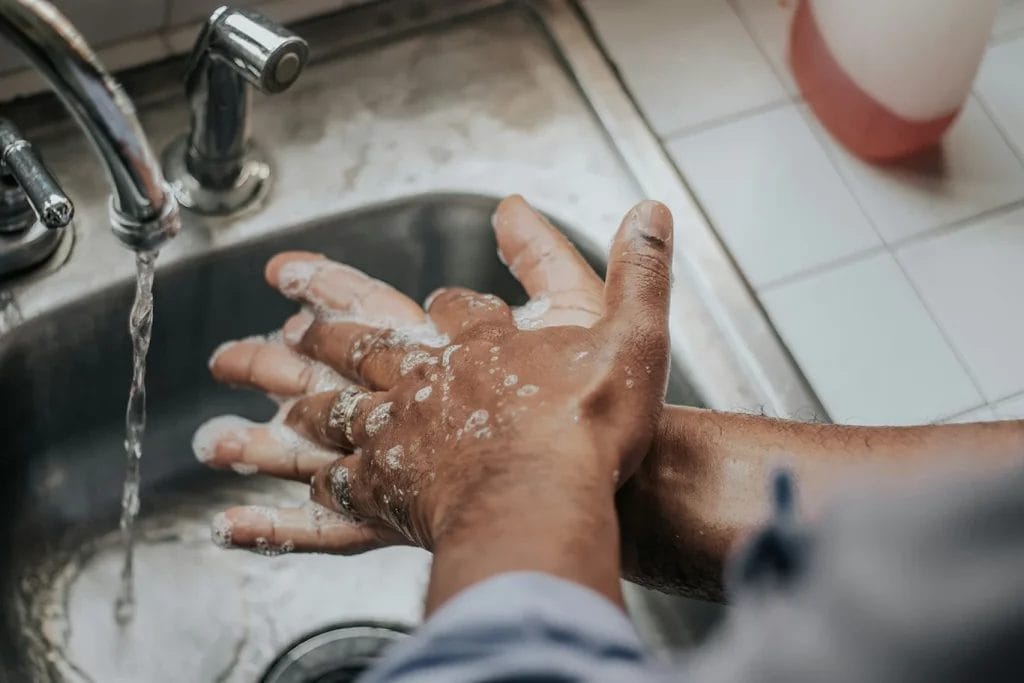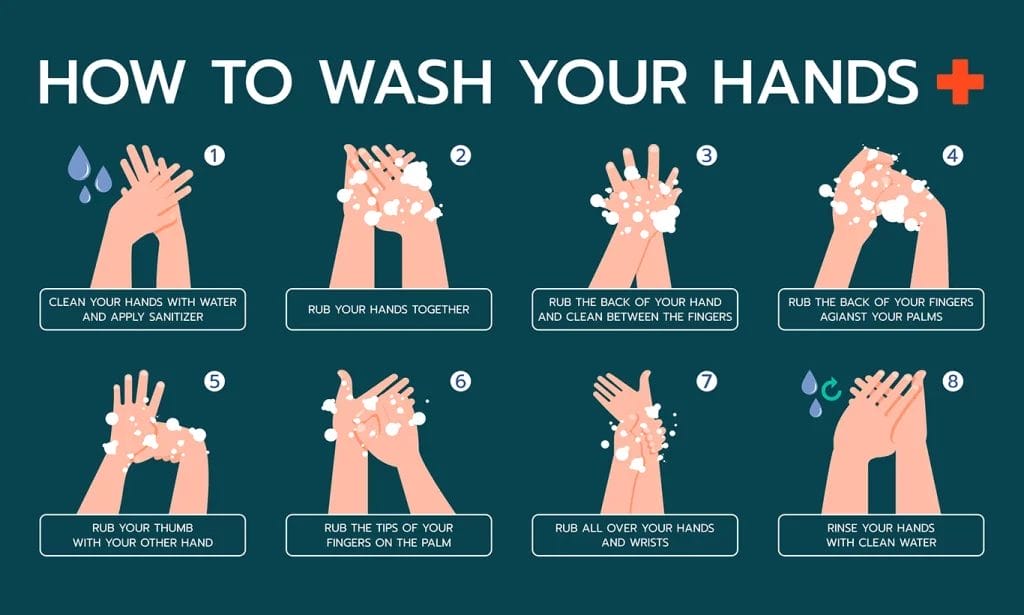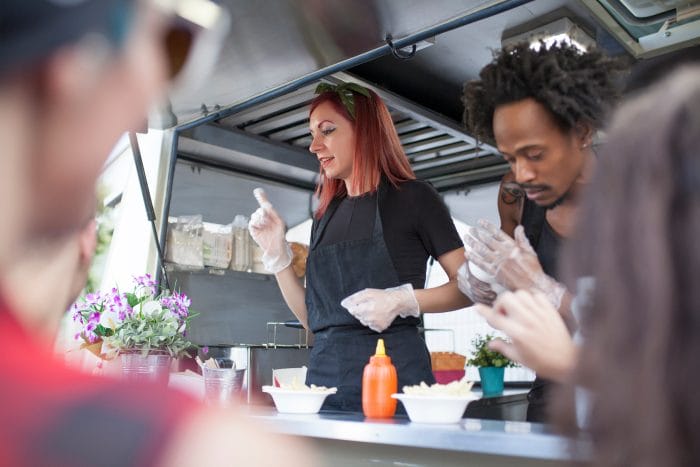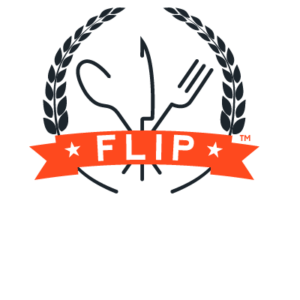The time has come.
You’ve been dreading this moment since you decided to start your food business, and now it’s finally here.
The health inspector has arrived.
Those in the food biz are all too familiar with the looming presence of the health department. Ever watchful, ever waiting to play “gotcha” and shut down their business.
But here’s the good news: neither the inspectors nor the Food Safety and Inspection Service are the bad guys. On the contrary, they’re here to safeguard all of us from preventable diseases and accidents.
Keeping your food truck or concession trailer up to code is good for your business, your customers, and you.
As the adage goes, “An ounce of prevention is worth a pound of cure,” which is why we’ve created this easy-to-follow food inspection checklist so you’ll be prepared the next time an inspector drops by.
How to Pass a Food Inspection
Guidelines and laws for food health inspections can vary depending on your state, but there are several key areas that any health department food inspection will cover.
Being proactive and conducting frequent self-inspections is one of the best ways to ensure you’re prepared for the real thing.
Be Aware of the Most Common Food Health Inspection Violations
The Centers for Disease Control and Prevention (CDC) receives around 800 reports of foodborne outbreaks a year, most of which originate in restaurants. Health department food inspections regularly uncover issues like:
- Poor Hygiene: When it comes to kitchens, dirty hands do the devil’s work. A USDA study on food handling revealed that 97% of participants failed to successfully wash their hands.
- Cross-Contamination: The same study showed that 5% of participants transferred bacteria to the salads they were preparing.
- Inadequate Sanitation: Failure to properly sanitize surfaces, utensils, and equipment can spread harmful bacteria, viruses, parasites, and chemicals.
- Improper Storage: From container placement to inadequate labeling, neglecting to store food properly can result in spoiled, expired, or contaminated stock.
- Temperature Control: Without adequate temperature control, pathogens in perishable foods can spread quickly.
Know What the Health Inspector Is Looking For
Temperature
Any chef worth their salt will tell you that good dishes start with good ingredients, and storage plays an important part in that.
One of the first things an inspector will look for is how your food is being stored, and this varies depending on what type of ingredients you need to keep on hand.
It’s crucial to comply with the temperature at which food and ingredients are stored. When in doubt, remember the Danger Zone, which is 40° F to 140° F. Dangerous bacteria like Salmonella and E. coli can as much as double every 20 minutes within this range, risking foodborne illnesses.
Prepared hot foods should be kept at or above 140° F if not being served immediately. However, the internal cooked temperature is a different matter.
- Beef, veal, lamb, and pork: 145° F
- Fish with fins: 145° F
- Ground meats: 160° F
- All poultry: 165° F
- Leftovers and casseroles: 165° F
When it comes to cold foods, your refrigeration should be set at 40° F and freezers should be set at 0° F.
Never leave cold ingredients sitting out at room temperature for more than two hours at the most. When you receive a shipment or get back with groceries, your priority should be to properly store your ingredients to keep them safe and delicious.
Pro Tip: Have thermometers available at all cooking stations and the most important temperatures posted as a reminder. You should also place appliance thermometers in your fridge and freezer to ensure they’re cooling properly.
Storage
- Top Shelf: Ready-to-eat items, such as deli meats, dairy products, or prepped food.
- Second Shelf: Fresh, raw seafood and sushi ingredients.
- Third Shelf: Raw meat and eggs. If possible, ground meat, fish, and marinades should be stored below or separate from these.
- Bottom shelf: All poultry, whole or ground.
- Items should be kept out of direct sunlight as much as possible.
- Food should be at least 6’’ off the floor, 18’’ away from outer walls, and 2’ from the ceiling.
- All cleaning chemicals need to be stored separately from any food, food containers, or prep areas.
Pro Tip: Before you open up for the day, include a quick inspection of your stock to make sure you have enough and that there are no expired items. Once customers arrive, you probably won’t be able to check labels every time you need to refill your prep area.
Labeling
Proper labeling just makes sense. Not only does it streamline your business operations, but it also helps prevent snafus during your food inspection.
Labeling requirements can vary by state or even county, but there are key elements you should always include:
- Product name
- Date the label was created
- The day and time the item was prepped
- An expiration or use-by date
- Any potential allergens the food may contain
This labeling process is especially important if you transfer products to your own containers rather than leaving them in their original packaging.
Pro Tip: Color coding your labels and containers for quick and easy identification during busy times and to speed up your daily self-inspections. Post a color key on the wall so everybody knows the system.
Cleaning and Sanitization
It should go without saying that sanitation goes hand-in-hand with food prep.
Cross-contamination can compromise the quality and safety of your products, especially in a smaller workspace like a food truck or cart. In addition to basics like taking out the trash and recycling, keeping your kitchen sanitary is a top priority.
It’s important to note that there is a difference between “cleaning” and “sanitizing,” and both are important: cleaning is the removal of dust and dirt, while sanitization is the removal of bacteria and other harmful pathogens.
Health department food inspection requirements and regulations can be dizzying, but it helps to break them down into two key areas: equipment and utensils (the stuff you can hold in your hand) and surfaces (appliances and anything else you can’t move easily).
Equipment and Utensils
The tools and containers you use to prep and cook are usually the last things your food touches before you pass it on to your customers. Everything you use should:
- Be free of cracks or dents that could hold onto old food and germs
- Not transfer toxic substances, odors, or tastes
- Not be absorbent
- Resist corrosion, wear, and tear
If your truck has a dishwasher, make sure it’s commercial grade and designed to heat to at least 171° F to sanitize everything adequately. Since some food businesses like food trucks or food trailers aren’t equipped with a dishwasher, you can also use the three-compartment sink method for washing dishes.
Every state has unique standards, so make sure to check with your local health department to make sure your procedures are up to code.
Surfaces
While it’s easy to notice when the dishes need washing, surfaces can easily fly under the radar if you’re not careful.
Consider making and posting a cleaning schedule to help everybody remember when and how often to wipe down and sanitize the various surfaces. Though it’s not required, it underscores your commitment to running a safe operation.
You’ll want to prioritize cleaning high-touch surfaces such as prep stations, warming areas, and cutting boards. It’s also important to pay attention to other areas of the kitchen that are easily forgotten, such as:
- Refrigerator and freezer handles and shelves
- Dry storage shelves
- Customer counters
- The sink, when not in use
- Walls
- Appliance exteriors (refrigerators, freezers, ovens/stoves)
- Beverage equipment (coffee makers, soft drink dispensers, coolers)
- Ventilation hoods
Since every operation is unique, you’ll need to examine your food truck to decide what surfaces and areas need to be addressed and how often they need it. For example, you probably won’t wipe down and degrease the walls every day, but workstations will need multiple deep cleanings per shift.
There are three chemical sanitizers approved by the Environmental Protection Agency (EPA) for use in food service: chlorine, iodine, and quaternary ammonium. These are considered food-safe and less likely to make you sick. Whatever sanitizer you choose, pay close attention to the instructions and use it accordingly.
Pro Tip: Always make sure your cleaning chemicals are formulated for kitchen use. The wrong products can result in some serious health hazards, or they could damage your equipment.

Personal Hygiene of Your Staff
In a study conducted by the CDC, workers only washed their hands one out of every three times that they should have.
Considering how easy it is to cross-contaminate surfaces and food with your hands, this is alarming. Moreover, a misstep in handwashing can be detrimental to your score in an inspection.
You can do a few things to improve that statistic in your establishment, though:
- Proper training is key, so make sure everybody knows when and why to scrub up.
- You should also have easy access to a dedicated sink and consider refining food prep to cut down on the need for handwashing.

According to the CDC, workers should wash their hands:
- Any time hands are visibly dirty
- Before and after work
- Before and after breaks
- After blowing their nose, coughing, or sneezing
- After using the restroom
- Before eating or preparing food
Depending on your product and your state’s laws, you may need to invest in Personal Protective Equipment (PPE). There are plenty of options out there, but the most useful choices for food prep include:
- Disposable gloves
- Face masks
- Aprons
- Hairnets
In a fast-paced environment like a food trailer or truck, you or your employees may be covering everything from prep to cashing out customers. Adequate PPE can prevent cross-contamination as you move between tasks.
It’s also important to note that inspectors will watch for behaviors and habits.
- Employees should always cover cuts or wounds with bandages.
- Jewelry ought to be simple, without nooks and crannies where bacteria can hide. Clean clothes and close-toed shoes are essential.
- Food and smoke breaks need to be taken away from food prep areas.
Pro Tip: Nitrile gloves are a smart choice since they are the least likely option to cause an allergic reaction.

Pest Control
Pests are more than just a pain when you work in the food industry, they’re a liability. Insects and rodents can destroy your stock, spread disease, and damage your equipment.
Worse yet, if a food inspector spots signs of an infestation, you could flat-out fail your inspection.
As always, prevention is the key when it comes to pests:
- Check for any signs of unwanted critters, including nesting sites and droppings.
- Rotate and examine dry goods frequently, looking for holes or chew marks.
- Never leave food out on counters or the floor.
- Make sure all packaging is airtight.
- Clean up spills promptly, including under tables and shelves.
- Inspect wiring for gnawing or bite marks.
If you do find any signs of pests, don’t waste time. Call a pest control specialist to deal with the problem ASAP to avoid further loss or damage. You can also invest in some pesticide-free prevention methods, such as live traps.
Pro Tip: When you pull out larger kitchen equipment like tables or ovens for cleaning, take the opportunity to inspect these often-ignored areas for any signs of infestation.
What Equipment Do You Need to Pass Inspection?
Having the right equipment goes a long way to keeping your food truck or trailer health inspection-ready.
With new and innovative developments in food technology, food safety is getting easier by the day. But, there are also plenty of tried and tested methods to keep your kitchen compliant.
One of the best choices you can make for your business is to opt for stainless steel whenever possible. This material is easy to clean, safe to sanitize, and unlikely to accumulate scratches and dents that can hold on to old food and bacteria.
Some other essentials include:
- A dedicated handwashing sink
- Commercial-grade equipment designed to handle the demands of the food industry
- Ventilation hoods to draw out smoke
- Adequate lighting throughout the workspace
- A fire suppression system
- A grease trap
- A clean water supply and safe disposal method
If you’re purchasing a food truck, trailer, or cart, many of these elements may already be installed. Before you hit your first event, have your equipment inspected for health and safety. From there, make sure you perform regular maintenance.
Pro Tip: Save some room on the wall to display your licenses and permits, because your inspector will be looking for them. Note that you may need a permit for every city you serve, so be prepared!
Protect Your Food Business From Risks With Food Liability Insurance
Inspections are stressful. But, if you take a proactive approach by following a food inspection checklist, you’ll be prepared when the health department comes around. Even when you do everything right, though, things can go wrong.
When it comes to food safety and insurance, JoAnne Hammer, Director of Program Development at Veracity Insurance Solutions, has this to say:
"Reducing the risk of illness or contamination in your food business through proper food safety management and complying with inspection recommendations is a simple yet impactful way to protect your business and customers, and to keep your operating costs lower."
That’s where Food Liability Insurance Plan (FLIP) comes in.
You work hard to make your business a success and we want to help you keep on (food) truckin’. Food liability insurance from FLIP provides a safety net for those times when issues arise that are out of your control. Here are just a few examples of how we can help:
- A near miss: You swerve to miss a deer on the way to an event. The animal and truck are fine, but the sudden turn threw several pounds of your pricey specialty coffee beans everywhere, making them unusable. FLIP could cover the expense of replacing your stock.
- Grease fire: Even though your grease traps are up to code, you don’t have time to clean them out during an especially busy day. The grease catches fire and ends up damaging the pavilion next to your rented spot. Our policy offers coverage for fire-related claims on property you rent for seven days or less.
- Unexpected allergens: You’ve followed guidelines for food allergy awareness and have all of your stock clearly labeled for allergens, but an employee accidentally cross-contaminated a container of rice with peanut oil. A customer with severe nut allergies ate the rice and ended up in the emergency room. FLIP’s product liability endorsement may cover these expenses.
Running a small business means you have a lot on your shoulders. We’re hoping we can make your life a little bit simpler by providing great resources, like this food inspection checklist, and offering the insurance you need to run your food business with confidence.

By Lindsey Fliger
Ohio-based copywriter Lindsey Fliger leverages her experience as a lifelong foodie, dedicated home chef, and very decent baker. She holds a bachelor’s in English from Kent State University and a master’s in English Literature from The University of Akron. Before Veracity, she wrote about everything from kitchen tools to decadent wines at Zulily.


